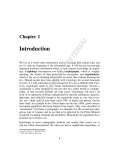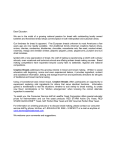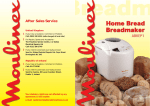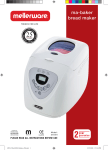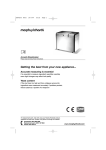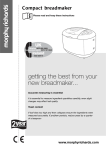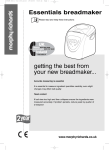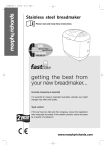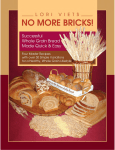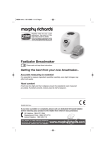Download Electrolux BR3000 Operating instructions
Transcript
Breadmaker.qxd 13/07/01 08:59 Page 1 BR3000 breadmaker Breadmaker.qxd 13/07/01 08:59 Page 2 Know your breadmaker Please read these instructions before using your breadmaker. i 1 Information 2 3 4 5 7 6 8 1. 2. 3. 4. 5. 6. 7. 8. Lid Plug Bread pan Baking chamber Bread pan handle Kneading blade Vents Control panel Also included: Measuring cup Spoon Breadmaker.qxd 13/07/01 08:59 Page 3 Information and advice Safety warnings and correct procedures. Your breadmaker should be used in such a way that it is protected from moisture. e.g. condensation, splashed water etc. Do not place or store your breadmaker where it can fall or be pulled into water or any other liquid. Stand your breadmaker on a stable, level surface during use. Do not allow your breadmaker to sit on top of the mains lead. Make sure that children cannot touch the breadmaker when hot or pull the mains lead. Do not allow young children to play with your breadmaker. Handle the bread pan with care. Remove the bread pan by pulling straight up on the handle using oven mitts. While in use, do not block up the steam vents or open the lid. ET E W CO H IT M PL G FI T TE D U PL Your breadmaker must not be used near or below curtains or other combustible materials. It must be watched when in use. Do not leave your breadmaker unattended. Your breadmaker should be placed away from heat sources such as radiators, gas/electric fires and direct sunlight. Keep the power cord away from any heated surfaces. Use the appliance only for its intended use, as described in this manual. Do not use outdoors. Never use your breadmaker if it is damaged in any way. Do not remove any fixed covers. If the power cable is damaged it must be repaired by a qualified repairer. The use of accessory attachments not recommended by the appliance manufacturer may cause injuries. Your breadmaker is supplied with an approved 13 amp fused mains plug. When replacing the fuse always use a 13 amp (BS 1362) approved type. If the mains sockets in your home differ or are not suitable for the type of plug supplied, then the plug should be removed and a suitable type fitted. Please refer to the wiring instructions at the back of this book. Breadmaker.qxd 13/07/01 08:59 Page 4 Preparing ingredients for a white loaf Check quantities of ingredients carefully. 1 2 3 i Information Remove the plug from the mains socket. Open up your breadmaker and remove the bread pan. Clean the surface of the breadmaker with a damp cloth and wipe dry. Wash the bread pan thoroughly before use. Make sure that the kneading blade is securely positioned on the drive shaft. 4 5 6 Pour 375ml of luke warm water into the bread pan. Put two level tablespoons (30g) of butter or margarine into the bread pan (you can use the spoon provided to measure both teaspoons and tablespoons). Put two level teaspoons of salt into the bread pan. All ingredients should be at room temperature (21-27ºC). Always measure ingredients into the bread pan in the order listed. The clips holding the bread pan in place may be stiff for the first few times that the bread pan is removed. Breadmaker.qxd 13/07/01 08:59 Page 5 7 8 9 i Information Pour 600g of strong, bread making flour into the bread pan. Put two level tablespoons (15g) of milk powder into the bread pan. Put two level teaspoons of sugar into the bread pan. Make a small hole in the mound of flour and put four level teaspoons of Easy Bake yeast into it. At this point do not let the yeast touch the water or salt! 10 11 12 Wipe down the outside of the bread pan and place it securely back into the baking chamber. Press the pan down until it locks into position. Close the breadmaker lid and plug into a mains outlet. The unit will beep and the display should read 1P for a couple of seconds and then change to 3:00. Press the MENU SELECT button continuously on the control panel to select the basic or rapid setting. Make sure that the bread pan is positioned securely back into the baking chamber. Align the bread pan with the brackets and press down without upsetting the mixture to lock into position. Breadmaker.qxd 13/07/01 08:59 Page 6 Using different baking settings 2 1 3 i Information Press the MENU SELECT button continuously on the control panel to select one of the following settings: Display 1P 2P 3P 4P 5P 6P 7P 8P Setting Time Basic 3:00 Rapid 2:20 Sweet 2:50 French 3:50 Quick 1:50 Whole Wheat 3:40 Dough 1:30 Bake 1:00 Each time the button is pressed you will hear a beep. You will need to use different settings for different recipes. Press the color button to select one of the following crust colours: P - medium crust H - dark crust L - Light crust Your breadmaker will automatically produce a medium crust colour unless you choose a different setting. Press the start/stop button to start baking immediately or alternatively see stage 3 if you wish to delay the baking time. You can add ingredients into your bread pan and set the timer to delay baking by up to 13 hours. This function is useful if you wish to have freshly baked bread at a certain time. Press the timer up or down buttons to set the time delay. e.g. If the time is 9.00 a.m. and you set the timer for two hours it will start to make bread at 11.00 a.m. On the basic setting your bread will be ready at 2.00 p.m. The display will show 5:00 (3:00 Basic + 2:00 time delay). Press the start/stop button to start the program. *The white loaf recipe is suitable for using timer delay. When using the timer feature for more than a couple of hours during hot weather, slightly increase the amount of water that you use in the mixture.Do not use the timer if your recipe includes fresh eggs, milk or other ingredients that may spoil. Breadmaker.qxd 13/07/01 08:59 Page 7 Removing the bread pan Always use oven gloves when the breadmaker is hot. 1 2 3 i Information When baking is finished the unit will signal and the display will show 0:00. Press the start/stop button down for 5 to 6 seconds until the unit sounds. Lift the lid of the breadmaker using oven gloves and remove the bread pan from the baking chamber. Remove the bread from the pan as soon as possible after baking. Hold the bread pan upside down and shake it gently. NOTE: If the breadmaker is accidentally unplugged, or in the event of power failure, the breadmaker will automatically resume power if the power comes back on within 6 minutes of the interruption. The keep warm setting will automatically continue to keep bread warm for up to an hour after baking has finished (except when using the dough setting). For best results remove the bread as soon as possible to stop the crust from getting soggy. Breadmaker.qxd 13/07/01 08:59 Page 8 Using other recipes The recipes in this book have been created in collaboration with Allinson. 1 2 3 i Information BRIOCHE ITALIAN POLENTA STICKS WHEATY YOGHURT BREAD 3/8 cup of butter (softened) 1 3/8 cups Allinson strong white bread flour 1 x 7g sachet Allinson Easybake yeast* 1/2 teaspoon salt 2 tablespoon sugar 2 eggs (beaten) 2 tablespoon milk 1 1/8 cups water 1 teaspoon sugar 1 teaspoon salt 1 teaspoon honey 1/8 cup butter (softened) 5/16 cup polenta 3/8 cup pine nuts 3 cups Allinson soft grain strong white flour 1 x 7g sachet Allinson Easybake yeast* 3/4 cup water 1 tablespoon skimmed milk powder 2 tablespoons honey 1 tablespoon sugar 1 tablespoon salt 1/2 cup natural yoghurt 1 tablespoon vegetable oil 3 cups Allinson country grain strong brown flour 1/8 cup Allinson wheatgerm 1 teaspoon Allinson Easybake yeast* Set the setting to Dough. When the breadmaker has finished, remove the dough and knead for 10 minutes. Divide the dough into 8 pieces. Reserve one fifth of each piece for the ball on top. Place each brioche into a muffin tin. Leave to prove until double in size. Bake at 190/375/Gas mark 5 for approximately 20 minutes. Set the setting to Dough. When the breadmaker has finished, remove the dough, divide into two and knead. Shape each piece into a long loaf and place onto greased baking sheets. Leave to rise until double in size. Bake at 190/375/Gas mark 5 for 25 minutes. Dust lightly with more softgrain flour. Set the setting to basic. *NOTE: We recommend you use only Easybake yeast - a combination of dried yeast and the bread improver Vitamin C (Ascorbic Acid). If you would like further information on breadmaking please call the Allinson Baking Club on: (0870 240 2237) and ask for a factsheet or visit their website at www.allinsonbaking.com The recipes shown opposite should only be used as a guideline and may need to be adapted. Breadmaker.qxd 13/07/01 08:59 Page 9 Tips for improved breadmaking Tips to help you improve your breadmaking. Ingredients: Use only fresh ingredients. Timer: When using the timer for delayed baking in warm weather conditions, you may need to reduce the yeast by ¼ to ½ teaspoon and use only half the amount of sugar called for in the recipe to prevent over-rising. Slicing: For best results always allow bread to cool before slicing. To slice warm bread use a sharp serrated-edge knife. Storage: After cooling completely, store immediately in a tightly sealed plastic bag, or covered container. Do not store in the refrigerator as this will cause the bread to dry out faster. For longer storage, tightly seal bread in a moistureproof bag and store in the freezer. Eggs: If you wish to add an egg to a recipe that does not include eggs, crack the egg into a measuring cup and fill with water to the level specified in the recipe. Cheese: Reduce the amount of water when adding cheese to a recipe as the cheese melts into liquid during baking. Cooling: To re-use the breadmaker immediately after baking, allow unit to cool down for 10 to 15 minutes with the lid open and the pan removed. Weather: In high humid weather, reduce the amount of water that you use in the recipe by 1 to 2 tablespoons. Temperature: If you are making bread in a cool room (under 18ºC) use warmer water (38-43ºC). Flour: Flour should be stored in a cool dry place and should stay fresh for up to two years. Always use highgrade flour for breadmaking and never use self raising flour. Bread mixes: You can use bread mixes in your breadmaker. Follow package instructions. Do not exceed bread pan capacity. *Yeast: Too little or too much yeast can result in your bread rising too little or too much. See information opposite... i Information *We recommend you use only Easybake Yeast. Easybake yeast is a combination of dried yeast and the bread improver Vitamin C (Ascorbic Acid). Ascorbic Acid guarantees the fast action of the yeast, allowing a quick rise and eliminating the need to 'knock back' the dough (therefore appropriate for use in breadmakers). Easybake Yeast can be added directly to the dry ingredients (there is no need for re-hydration) and the dough will only require one kneading and one period of proving. Breadmaker.qxd 13/07/01 08:59 Page 10 Troubleshooting Fixing problems that may occur when making bread Problem Cause Solution The unit does not operate after pressing the Start/Stop button. The unit is unplugged? Setting was not selected? Plug into an electrical socket. Select the setting that you require from the setting menu. The bread rose to high. Too much yeast or moisture? Check the recipe and make adjustments according to humidity (see tips page for further details). The bread didn’t rise high enough. Too much flour or not enough yeast? Check the recipe and make adjustments according to humidity (see tips page for further details). H:HH is shown in the display and the unit is beeping. Unit is too hot. Press the Start/Stop button to cancel. Open the lid, remove the bread pan and allow unit to cool with the lid open. L:LL is shown in the display and the unit is beeping. Room temperature is too low. Press the Start/Stop button to cancel. Place breadmaker in a warm room and allow to warm up. E:EE is shown in the display and The sensor is open. the unit is beeping. Unplug from the socket. It must be repaired by a qualified repairer. i Information Never use scouring pads or other abrasive materials or chemicals to clean your breadmaker as this could cause damage. Customer Service The highest quality requirements are placed on our appliances. However, should a malfunction occur for which you cannot find any information in the operating instructions, please contact your local Dixons or Currys store. Because we continually strive to improve our products, specifications may change without prior notice. Breadmaker.qxd 13/07/01 08:59 Page 11 Wiring instructions Specifications: 230-240V ~ 50Hz 715-770W The wires in your breadmaker’s power cord are coloured as follows: Green & Yellow (Earth) E Brown (Live) Blue (Neutral) N The wire which is coloured Green and Yellow must be connected to the terminal in the plug which is marked with the letter E or by the Earth symbol, or coloured Green or Green and Yellow. The wire which is coloured Blue must be connected to the terminal in the plug which is marked with the letter N or coloured Black. 13 amp fuse L Cord grip This appliance must be earthed. If the power cable is damaged it must be repaired by a qualified repairer. The wire which is coloured Brown must be connected to the terminal in the plug is or marked with the letter L or coloured Red. Remove anywhich stickers protective foil and unroll mains You must a 13 amp line plug(BS 1363), and fit a 13 amp lead. This use is with a fourth 1362). fuse(BSThis added. is with a fifth line of text. WARNING. A mains plug severed from the mains lead of this appliance must be destroyed. A mains plug with bared wires is hazardous if engaged in a mains socket. We continually strive to improve our products, specifications may change without notice. No part of this publication may be produced, stored in a retrieval system or transmitted in any form or by any means, without the prior permission in writing of Dixons Stores Group, nor be otherwise circulated in any form or binding or cover other than that in which is published and without a similar condition including this condition being imposed on the subsequent purchaser. Breadmaker.qxd 13/07/01 08:59 Page 12












